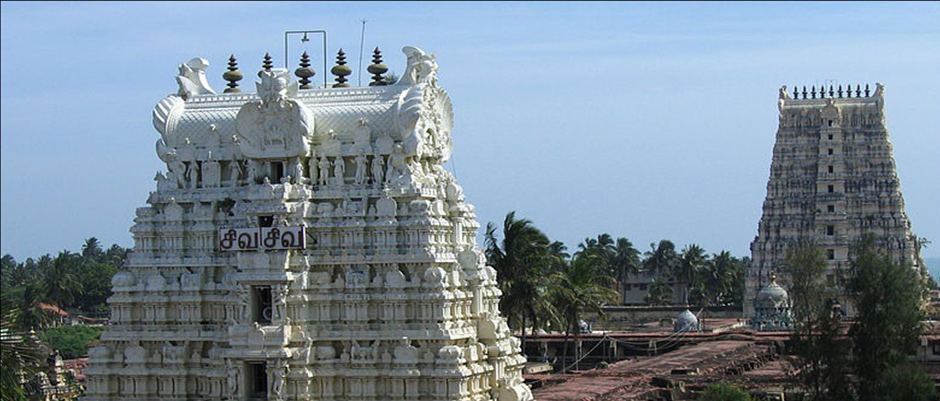
Rameswaram Temple
Ramanathaswamy Temple – A Sacred Jewel on the Island of Rameswaram
Nestled on the serene island of Rameswaram in Tamil Nadu, Ramanathaswamy Temple stands as a towering symbol of faith, history, and architectural brilliance. Revered by millions, this sacred shrine is dedicated to Lord Shiva and holds a place of pride among the twelve Jyotirlingas, the holiest abodes of Shiva on Earth.
A Divine Connection with Lord Rama
According to ancient tradition, after triumphing over Ravana in Lanka, Lord Rama paused at the coastal land of Rameswaram before continuing his return to Ayodhya. Since Ravana was known to be a devoted worshipper of Lord Shiva, Rama wished to make amends through worship, feeling it was important to honor Shiva and seek spiritual purification.
To seek forgiveness and offer his reverence, Rama decided to perform a puja to Lord Shiva by installing a Shiva Lingam. He entrusted Hanuman with the task of bringing a lingam from Mount Kailash. However, as the pre-determined time for the ceremony approached, Hanuman had not returned. Without further waiting, Sita fashioned a sand lingam on the seashore. This became the revered Ramalingam.
Later, when Hanuman arrived with the lingam from Kailash, he was disheartened. To honor Hanuman’s devotion, Rama declared that the Kailash Lingam, now known as Vishwalingam, would be worshipped first — a tradition that continues to this day.
A Temple Embraced by Saints and Scriptures
Ramanathaswamy Temple is among the 275 Paadal Petra Sthalams, praised in the hymns of Shaivite saints like Appar, Sundarar, and Sambandar. These sacred verses echo the temple’s divine presence and spiritual potency.
The Shiva Purana and Yuddha Kanda of the Ramayana also narrate Rama’s deep devotion on this very island. They describe his meditations, chanting, and penance offered to Shiva — acts that earned him divine blessings and victory in battle.
Historical Contributions Across Dynasties
Over the centuries, kings and chieftains from near and far contributed to the temple’s growth. The Pandya dynasty in the 12th century expanded its structure, while rulers from the Jaffna Kingdom in Sri Lanka, such as Jeyaveera Cinkaiariyan and Gunaveera Cinkaiariyan, undertook key renovations. Stone from Koneswaram Temple in Trincomalee was even transported across the sea for this purpose.
Further patronage came from the Maratha rulers of Thanjavur, who established rest houses for pilgrims in and around Rameswaram between the 18th and 19th centuries. Sri Lankan monarchs like Parakrama Bahu and Nissanka Malla also contributed significantly by sending artisans and making generous donations.
Sanctity Through Sacred Waters
One of the temple’s most unique features is the presence of 22 teerthams, or holy water tanks, within its complex. Each of these ponds is believed to have distinct healing qualities. Devotees describe powerful spiritual experiences after bathing in them — from confronting their past misdeeds to feeling an overwhelming sense of inner peace and clarity.
The waters are said to have been created by Rama himself, who shot arrows into the earth to draw out sacred springs. Even today, pilgrims flock to these teerthams, believing that a dip here can purify one’s soul and lead to spiritual liberation.
A Marvel of Dravidian Architecture
Sprawling across 15 acres, the temple is a masterpiece of Dravidian architectural style. Towering gopurams (gateway towers) rise majestically above the skyline, while massive granite corridors supported by intricately carved pillars stretch in all directions.
One of the most astonishing features is the third corridor, which measures around 3800 feet in total length and includes more than 1200 pillars, each 22 feet tall. Among the many architectural marvels of this shrine, the temple corridor stands out as the longest of its kind in any Hindu temple across India, drawing awe and admiration from all who walk its path.
The temple’s sanctum sanctorum, or garbhagriha, houses both the Ramalingam and the Vishwalingam, and stands as the spiritual heart of the complex. Within the temple complex, one can find a grand statue of Nandi, the divine bull associated with Lord Shiva, radiating strength and devotion. Surrounding the sanctum are five important halls — Kalyana Mandapam, Nandi Mandapam, Setupati Mandapam, Sukravara Mandapam, and Anuppu Mandapam — each contributing to the temple’s sacred ambiance and ceremonial functions.
Unique and Lesser-Known Facts
In 1935, the British Indian Postal Department issued a commemorative stamp featuring the Rameswaram Temple, highlighting its national significance.
Despite being located close to one another, the 22 teerthams differ in taste, temperature, and mineral properties — a phenomenon yet to be fully explained by science.
Swami Vivekananda, before departing for his historic Chicago speech, visited the temple to seek blessings, further enhancing its spiritual legacy.
Why Rameswaram Holds the Heart of Devotees
Whether you're a Shaivite, Vaishnavite, or Smarta, the sanctity of this temple resonates deeply. It forms one of the four Char Dham pilgrimage sites, the others being Badrinath, Dwarka, and Puri. Devotees believe that only after visiting Rameswaram does a pilgrimage attain its true completion.
Many also visit to perform ancestral rituals and ceremonies, seeking peace and salvation for departed souls. Performing abhishekam (ritual bathing of the lingam) here is considered an act of the highest spiritual merit.
In Closing: A Journey Within
To walk the sacred corridors of Ramanathaswamy Temple is not merely a physical journey — it is an inward one. From the echoes of Vedic chants to the chill of teertham waters trickling down the spine, every element here speaks of transcendence and grace. For the devout, the temple is not just a structure of stone but a living embodiment of Rama’s humility, Shiva’s benevolence, and the soul’s yearning for liberation.
Temple Timings:
Morning: 5:00 AM – 1:00 PM
Evening: 3:00 PM – 9:00 PM
